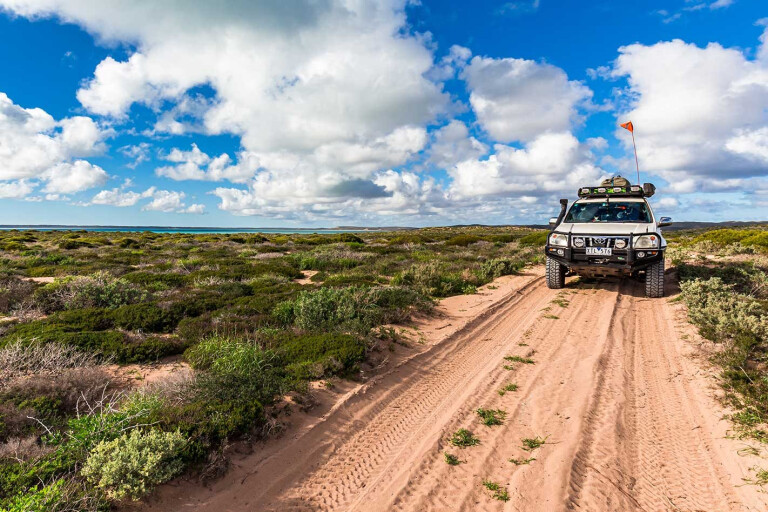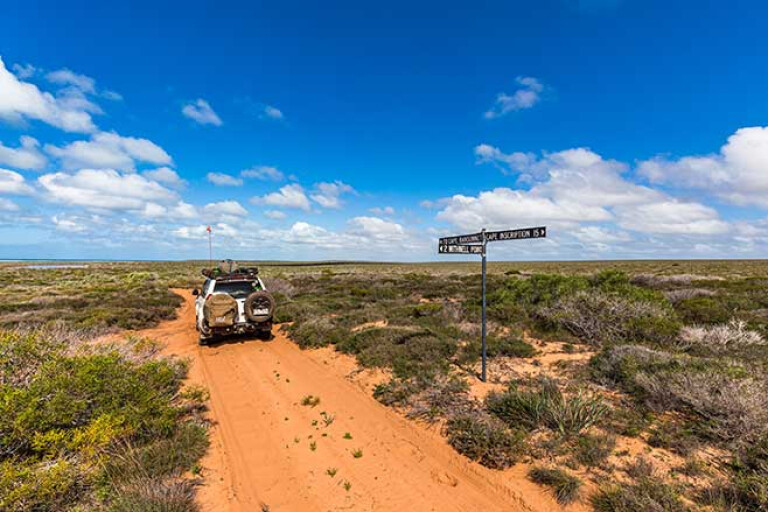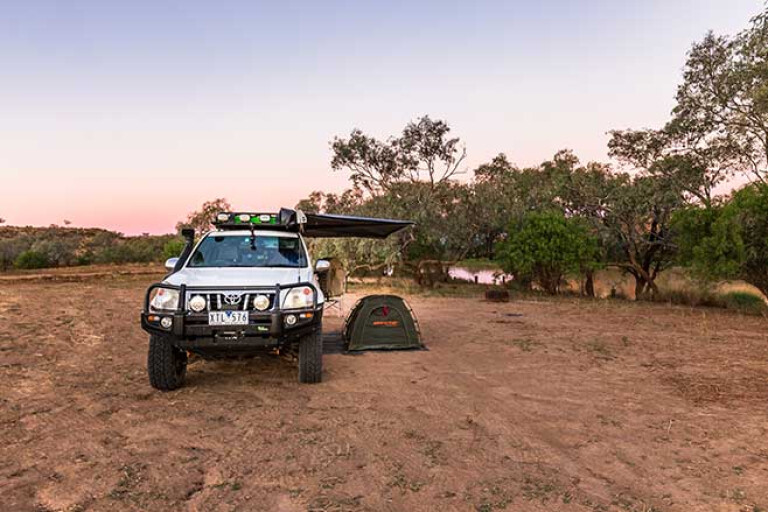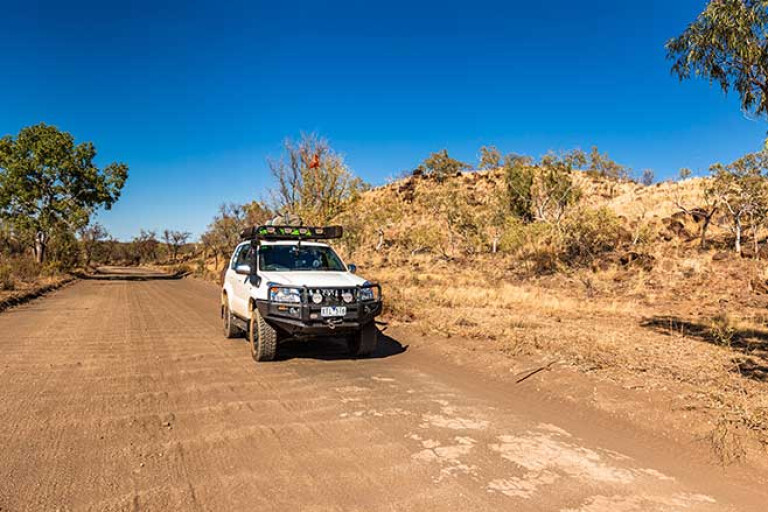
THE world’s gone crazy over a virus named after a Mexican beer and everyone is in lockdown creating a side-effect known as ‘wallclimbitis’.
Thankfully, once things settle down and we’re finally allowed to leave our homes, this great land of ours has some of the best locations to head to and get your travel juices flowing.
Towns will welcome you with open arms and there’ll be no issues getting any toilet paper, rice or alcohol. Permits will be given out again for access to Aboriginal lands and National Parks; while caravan parks and farm stays will all be open again. This will be Australia as we know it: open borders, no travel restrictions and the freedom to choose what we do and where we go. Don’t despair, we will get there.
These five destinations were chosen because they’ll take a bit of effort to get there, but the reward on making it will blow you away.
DIRK HARTOG ISLAND
WHAT better place to recharge than a remote island on the West Australian coast, accessible only by boat. I can’t think of a place I’d rather be than Dirk Hartog Island. First discovered by the Dutch sea captain Dirk Hartog, who climbed the cliff face at Inscription Point and used a copper nail to mount an etched pewter dish to a pole; the year was 1616.
The only way to access the island with a 4WD is via the barge that travels across the strait from the mainland at Blackies Beach Steep Point, a challenge in itself to get to. With the island being so isolated, you’ll need to be self-reliant and fires aren’t permitted within the national park, so pack a portable gas cooker. The ecological environment is fragile, too, so leave only footprints, take only photos and remove all rubbish.
Kieran Wardle and wife Tori have turned The Homestead area into an accommodation precinct for visitors, that include the rustic luxury Eco Lodge, an Ocean Villa and camping sites. In fact, they’re currently offering a Self-Isolation Package at Jed’s Camp on Homestead Bay. For $250 per night, you’ll get camp fees for up to 10 adults, private bathroom and fresh hot-water showers and camp kitchen overlooking the ocean (w/ tables and chairs, gas barbecue and cooker), just BYO 4WD and fishing gear.

One of the island’s highlights is the Blow Holes, and after conquering a couple of rough dunes you’ll get to drive across one of the massive drifting sand dunes before the Indian Ocean comes into view. How active the Blow Holes are is dependent on the ocean swell, purring like a kitten some days but roaring like an angry dragon on others.
The National Park offers 4WD adventurers some amazing camping destinations and, while caravans are not permitted on the island, an off-road camper trailer will eat up the sandy tracks. Grab a site at Louisa Bay on the beautiful east coast of the island, it’s the perfect spot for the kids to swim, snorkel or paddleboard in the shallow water.
Just you and your partner? Try the seclusion at Turtle Bay and get some romance back in your life during these difficult times, with long walks along the white sandy beach or swimming in the turquoise Shark Bay water while keeping an eye out for whales, rays, dolphins and, of course, sharks.
If throwing in a line to wile away your self-isolation woes, Withnell Point, Urchin Point or The Block are the best spots; although, only Withnell Point is suitable for small children. Don’t forget to explore what curious items have been washed up on Mystery Beach and top off your visit by enjoying the last sunset in Australia at Herald Heights (it’s the most westerly point in Australia to watch the setting sun).
KARLAMILYI NATIONAL PARK
AS the largest and most remote national park in Western Australia, Karlamilyi (Rudall River) is the perfect place to get back to nature. The corrugations at the Talawana Track end are savage and last for 30-odd kilometres, so less air in your tyres will help here. Check out the vistas as you hug the Fingoon Range, they’re absolutely stunning. Access from the north is via the Telfor/Kiwirrkurra Road.
The park is accessible by high-clearance 4WD only and has no facilities, few signs and rough, unmaintained tracks and you’ll need to be self-sufficient and carry adequate water, food and fuel. A satellite phone or HF radio is highly recommended; although becoming more popular with overlanders, you still may not see anyone for days out here.
Rudall River was named by explorer Frank Hann when he met government surveyor William Rudall, who was searching for lost members of a scientific expedition. The traditional owners of the land, the Martu people, call the upper reaches of the river Waturarra and the lower reaches Karlamilyi.

The track into Desert Queen Baths is low-range stuff, but going slow allows you to soak in the natural beauty on show. Camping is permitted at the end of the vehicular track, with some shade available from the saplings. From here it’s a walk into the Desert Queen Baths via an unmarked, rocky trail. Many like to swim here, though the water is always extremely cold.
Camping is also allowed on the banks of Watrara Pool, a permanent waterhole lined with river gums on the Rudall River. You’re likely to spot mobs of camels roaming the plains out here. This is the better of the two camping areas as its more secluded and the waterhole has a sandy base, ideal for a swim. From here, it’s easy to take day trips out to Desert Queen Baths.
It’s not just the remoteness of this national park in the Pilbara that makes it so special, it’s also the beauty of the landscape with the desert oaks, bloodwoods and spinifex, and the permanent pools that attract more than 140 species of bird. The reptiles are hardy, too, bred tough for these conditions and more likely to be spotted during the cooler times of the day from dusk to dawn.
VICTORIAN HIGH COUNTRY
WE are spoilt with the expansive area available to explore in the Victorian High Country, and there are a plethora of camping spots where you can enjoy pure isolation. Some areas have been affected by the recent devastating bushfires, and while many communities are crying out for visitors and emptyesky.com.au is all the rage, please don’t buy all the toilet paper, hand sanitiser, rice or pasta.
The Wonnangatta Valley is a superb place to ride out the pandemic and there is plenty to explore while you’re there, especially the 4WD tracks. Tackle the challenging Zeka Spur Track that leads you up to Howitt Hut, or the Wombat Range Track, one of the steepest climbs in the High Country. If you’re towing an off-road camper trailer, the Abbeyard/Lake Buffalo option is the easiest way in.
There’s a fair bit of history in the Valley itself, including a murder mystery that has never been solved. The old Wonnangatta Station site explains the story of James Barclay and John Bamford, and here you’ll also find the old cemetery and old homestead ruins. With plenty of distance between the riverside campsites, you’ll certainly be safe from contamination.

The township of Omeo is a great jump-off point to find a special campsite. Whilst the free camping behind the Hilltop Hotel is tempting, I reckon Davies Plain Hut would be a safer option. Limestone Track is not to be taken lightly and a better option is the Buckwong Track. Keep a sharp eye out for wild brumbies, and the hut has some resident gang-gang cockatoos that are extremely photogenic; with the nearby creek offering crystal-clear High Country water. Take out what you bring in and ensure your fire is out before you leave.
Another great spot to refresh is in the Dargo district, where you can grab some fantastic grub and top up your beverage supply at the Dargo Hotel. There are plenty of sites along the Dargo River to choose from, or you could head out to Talbotville and set up beside the Crooked River.
There is plenty of history to discover, especially from the early gold mining days; and the old Grant townsite has a great walking trail that highlights the challenges these people endured. Another great day trip is via the Dargo High Plains Road up to Blue Rag Track, one of the High Country’s most iconic 4WD tracks, where you can enjoy the most superb views across the ranges.
DIAMANTINA NATIONAL PARK
ONE of the top campsites in Outback Queensland is at Hunters Gorge in Diamantina National Park, and being so remote makes it one of the best locations for rejuvenation. Just getting here can be a challenge, but having the opportunity to relax and enjoy what the national park has to offer is a real bonus.
The old homestead and ranger base offer an information centre that explains the history of the place, from the first interaction between Aboriginals and the Europeans in the early 1800s. The traditional owners still consider areas of the Diamantina National Park to be significant sites relating to the Dreamtime. The rangers are not always on-site, so a satellite phone is an important tool out there.
There are great views across the Diamantina Gates from Janets Leap. The ‘gates’ are the shortest distance between the Hamilton and Goyder Ranges, about one kilometre, which squeezes the Diamantina Channels into one before the water spreads into five main channels again. During a flood, it’s an incredible phenomenon to witness as the water plunges through this gorge.

A self-drive tour on the Warracoota Circuit Drive is approximately 90km in length and will take you at least four hours to take in the experience. Mitchell grass plains, old rodeo yards, ruins, desert red sand dunes, gibbers, waterholes and boggy holes, it has it all. There is even a set of ruins three kilometres from the Warracoota Waterhole, thought to have been built by early settlers, but, as you’ll see, the layout looks more like a battlement.
There are two designated camping areas within Diamantina National Park, with pit toilets the only facility at both sites. The best being Hunters Gorge, an open and spacious area that sits beside a permanent waterhole and is suitable for off-road caravans and camper trailers. Gum Hole has small individual sites with plenty of shade provided by the coolabah and bauhinia trees that line Whistling Duck Creek.
Both sites are perfect for a canoe or kayak, especially at dawn and dusk when the resident
birds are active. Expect to see Hall’s babblers, whistling kites, black falcons and oriental plovers, and as you drive around the park you’re sure to encounter emus, and western grey and red kangaroos. If photography is something you enjoy, the sunrises and sunsets are often extremely vibrant, as are the burnt orange sand dunes and colourful wildflowers.
PURNULULU NATIONAL PARK
AS a natural wonder, Purnululu (Bungle Bungles) National Park has only been a tourist hot spot for a few of decades, but Aboriginals have known about it for thousands of years. These days it’s one of the most visually stunning, world-heritage-listed national parks in Australia.
The road into the national park is notorious for being rough, but deflate your tyres a bit, reduce your speed and you’ll get to enjoy the views of the Osmond Range on the way. A high-clearance 4WD is recommended and only single-axle off-road caravans or camper trailers are permitted. Once you’ve entered the park, a visit to the ranger station to check in is a requirement. They’ll want to see your WA Park Pass and campsite booking, and there is a Wi-Fi hotspot outside the station that enables you to pay your park entry and camping fees online.
There are two camping areas within this remote wilderness: Walardi is closer to the Cathedral Gorge and Piccaninny Creek; while Kurrajong is nearer to Echidna Chasm and Mini Palms Gorge. Both sites have pit toilets and a non-potable water tap, so you’ll need to be self-reliant and bring in all your food, water and fuel.

If a bit of luxury helps you to relax and rejuvenate, the Bungle Bungle Savannah Lodge is the place to stay. Located within the national park you’ll enjoy the ambience and comfort of a modern cabin with en suite. The lodge relies totally on solar power to keep it running and the hot water is backed up by LPG gas as it can be very cold in the mornings.
All meals are prepared on-site by the experienced chefs with breakfast, lunch and dinner available. The Bungles Bar is open daily and there’s no better way to finish the day sitting next to a fire with a beverage, chatting with fellow travellers.
It’s the ancient geological wonders that make this national park so special and having time to explore it makes it even better. At Echidna Chasm you can watch its walls change colour as the sun moves across the sky, while Mini Palms Gorge is full of prehistoric Livistona palms within its natural amphitheatre.
Cathedral Gorge has stunning acoustics and The Domes have weathered over thousands of years to get a banded look like a beehive.
Piccaninny Creek is an attraction all on its own as the trail leads you to The Window, a natural hole in the sandstone, and onto Whip Snake Gorge with its small permanent pool feeding rock figs, ferns and mosses. For the experienced walkers, Piccaninny Gorge is a one- or two-night trek that you must register for at the visitor centre, carry sufficient food, water and clothing and carry a satellite phone or Personal Locator Beacon (PLB).
The best way to experience the expansive wonders of Purnululu is in the air, and HeliSpirit offers several packages flying from within the park at Bellburn airstrip. It also offers a full-day heli-hike that lands you near the mouth of Piccaninny Gorge where it splits into five fingers. An Aboriginal guide then leads you on a 10km return hike explaining the cultural significance of Purnululu.

COMMENTS